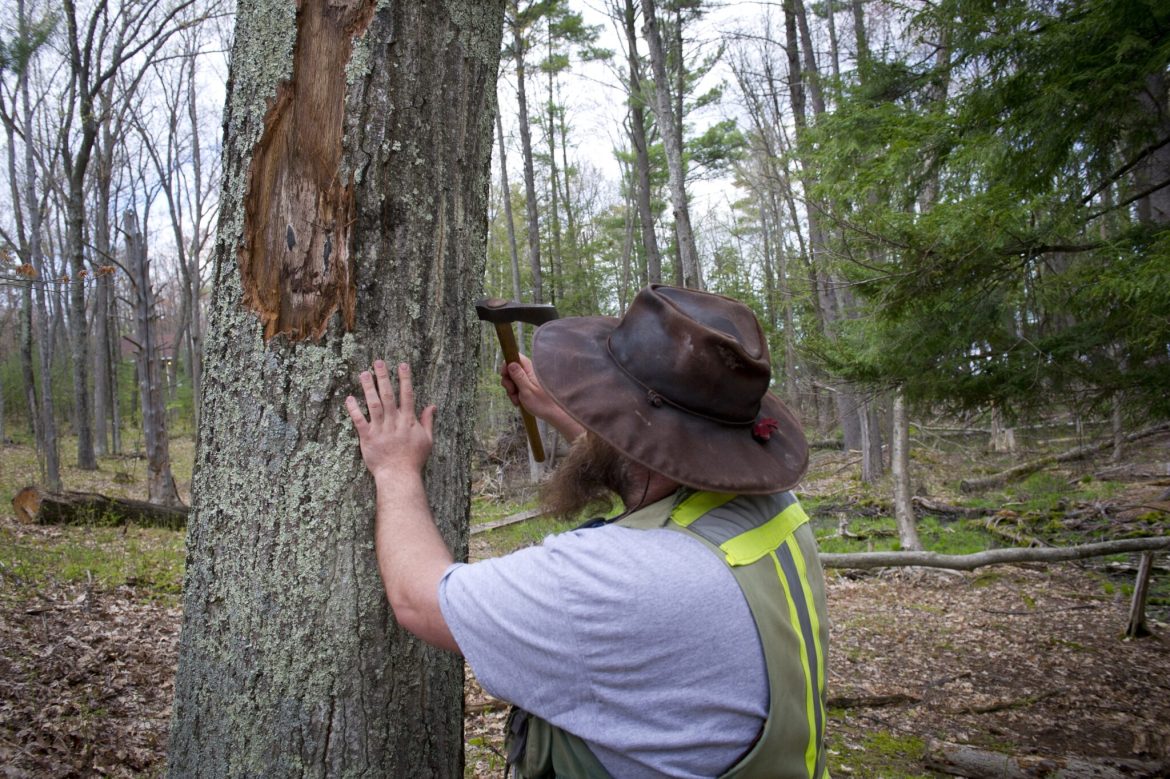
Oak leaf wilt in Grand Traverse County near Interlochen. Phillip Kurzeja of the Department of Natural Resources checks under the bark for pressure pads. Credit: David Kenyon/ Department of Natural Resources
By Eric Freedman
Capital News Service
The mighty oak may be in trouble in the Great Lakes region – and climate change is largely to blame.
A mix of factors is in play, including rising temperatures, more severe and intense rainstorms, increasing susceptibility to plant-eating animals and vulnerability to disease-causing microorganisms, a new study from Michigan Technological University says.
“Oaks have evolved a range of adaptations to dry and hot conditions and have an increased range of suitable habitat with climate change,” according to the study in the journal Forests.
They were a pioneer species in the Great Lakes region before widespread European settlement, said Amanda Stump, the lead author of the research, and can do well with extreme temperatures.
Even so, the study warns, warmer winters, extreme weather events, diseases and extended ranges of herbivores “may still put oaks at risk.”
And that can jeopardize what Stump describes as the important role oaks play in supplying food – acorns – in the fall for bears, turkeys, birds and other wildlife.
The state Department of Natural Resources recently reported that oak wilt, a fungal disease, has been discovered in southwestern Marquette County. It says the often-deadly disease is moving into new areas of the Upper Peninsula.
Woe – for the mighty Tree!
The monarch of the plain –
The storm hath reft its noble heart –
It ne’er shall tower again.
Poet Lydia Howard Sigourney
There are 600 oak species around the world, 10 of them native to the state, according to Michigan State University Extension. The U.S. Forest Service estimates there are 604 million oaks in Michigan.
The study said warmer winters increase the survival rate and fertility time of harmful insects, stress the trees and increase the range of pathogens and plant-eaters that beset them.
Harmful insects give good cause to worry.
The two-lined chestnut borer is now “the most important insect cause of oak mortality,” especially for stressed, injured and weakened trees, according to Wisconsin Horticulture at the University of Wisconsin Madison.

Two-lined chestnut borer. Image: George Heaton/ U.S. Department of Agriculture
“Many stressors can weaken oaks and open them to attack by this insect: environmental extremes, defoliation by leaf-feeding insects, diseases, physical injury, girdling roots soil compaction and road salt injury,” Wisconsin Horticulture says.
A life near end, only nature will fear,
The absence of its beauty, the forest will know,
The strength, the beauty, and seedlings it shared,
Fulfilling its duty, as nature sheds a tear.
Poet B.J. Ayers
The study from Michigan Tech’s College of Forest Resources and Environmental Science identified other current insect threats, such as spongy moths, leaf miners, red oak borers and sap beetles.
More dangers loom: The study pointed to “emerging insects of concern,” such as oak gall wasps and oak borers.
“With changing temperatures and other climatic conditions, insects which affect oaks in areas of North America or the world may be introduced to new areas and become problematic,” the study said. “An invasive species that targets oaks could be the next threat whose range expands rapidly and causes ecological disturbance and economic damage.”
Stump said invaders might sneak into the United States with shipments of timber, meaning there’s a need for vigilance, inspection and sanitizing of imported timber.
The study acknowledged the difficulty of predicting the next key threat that oaks face. “One barrier,” it said, “is simply knowing the current state or location of insect or pathogen threats, particularly in rural or wilderness areas.”
Fire – or rather the absence of enough fire – poses another challenge for oaks.
“Fire is a disturbance agent that promoted oaks prior to and even after European settlement era” and has played a major role “in maintaining and shaping what we have now,” said Jason Hartman, the Grayling-based state silviculturist in the Forest Resources Division of the Department of Natural Resources.
Oak seedlings develop large root systems that can sprout well and have adapted to repeated surface fires in ways that red maples and other species haven’t, Hartman said.
